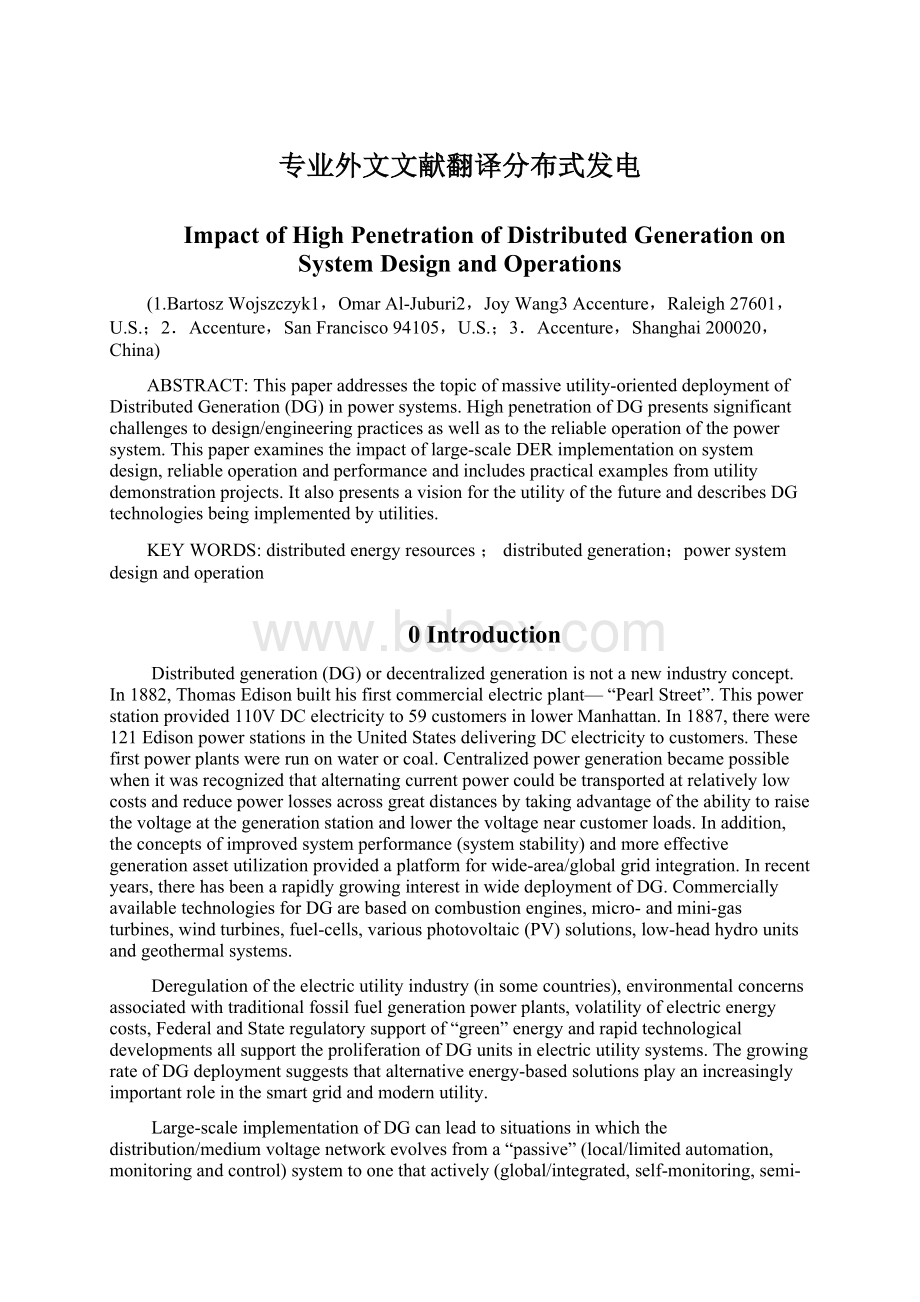专业外文文献翻译分布式发电.docx
《专业外文文献翻译分布式发电.docx》由会员分享,可在线阅读,更多相关《专业外文文献翻译分布式发电.docx(9页珍藏版)》请在冰豆网上搜索。

专业外文文献翻译分布式发电
ImpactofHighPenetrationofDistributedGenerationonSystemDesignandOperations
(1.BartoszWojszczyk1,OmarAl-Juburi2,JoyWang3Accenture,Raleigh27601,U.S.;2.Accenture,SanFrancisco94105,U.S.;3.Accenture,Shanghai200020,China)
ABSTRACT:
Thispaperaddressesthetopicofmassiveutility-orienteddeploymentofDistributedGeneration(DG)inpowersystems.HighpenetrationofDGpresentssignificantchallengestodesign/engineeringpracticesaswellastothereliableoperationofthepowersystem.Thispaperexaminestheimpactoflarge-scaleDERimplementationonsystemdesign,reliableoperationandperformanceandincludespracticalexamplesfromutilitydemonstrationprojects.ItalsopresentsavisionfortheutilityofthefutureanddescribesDGtechnologiesbeingimplementedbyutilities.
KEYWORDS:
distributedenergyresources;distributedgeneration;powersystemdesignandoperation
0Introduction
Distributedgeneration(DG)ordecentralizedgenerationisnotanewindustryconcept.In1882,ThomasEdisonbuilthisfirstcommercialelectricplant—“PearlStreet”.Thispowerstationprovided110VDCelectricityto59customersinlowerManhattan.In1887,therewere121EdisonpowerstationsintheUnitedStatesdeliveringDCelectricitytocustomers.Thesefirstpowerplantswererunonwaterorcoal.Centralizedpowergenerationbecamepossiblewhenitwasrecognizedthatalternatingcurrentpowercouldbetransportedatrelativelylowcostsandreducepowerlossesacrossgreatdistancesbytakingadvantageoftheabilitytoraisethevoltageatthegenerationstationandlowerthevoltagenearcustomerloads.Inaddition,theconceptsofimprovedsystemperformance(systemstability)andmoreeffectivegenerationassetutilizationprovidedaplatformforwide-area/globalgridintegration.Inrecentyears,therehasbeenarapidlygrowinginterestinwidedeploymentofDG.CommerciallyavailabletechnologiesforDGarebasedoncombustionengines,micro-andmini-gasturbines,windturbines,fuel-cells,variousphotovoltaic(PV)solutions,low-headhydrounitsandgeothermalsystems.
Deregulationoftheelectricutilityindustry(insomecountries),environmentalconcernsassociatedwithtraditionalfossilfuelgenerationpowerplants,volatilityofelectricenergycosts,FederalandStateregulatorysupportof“green”energyandrapidtechnologicaldevelopmentsallsupporttheproliferationofDGunitsinelectricutilitysystems.ThegrowingrateofDGdeploymentsuggeststhatalternativeenergy-basedsolutionsplayanincreasinglyimportantroleinthesmartgridandmodernutility.
Large-scaleimplementationofDGcanleadtosituationsinwhichthedistribution/mediumvoltagenetworkevolvesfroma“passive”(local/limitedautomation,monitoringandcontrol)systemtoonethatactively(global/integrated,self-monitoring,semi-automated)respondstothevariousdynamicsoftheelectricgrid.Thisposesachallengefordesign,operationandmanagementofthepowergridasthenetworknolongerbehavesasitoncedid.Consequently,theplanningandoperationofnewsystemsmustbeapproachedsomewhatdifferentlywithagreateramountofattentionpaidtoglobalsystemchallenges.
Theprincipalgoalofthispaperistoaddressthetopicofhighpenetrationofdistributedgenerationanditsimpactongriddesignandoperations.Thefollowingsectionsdescribeavisionforthemodernutility,DGtechnologylandscape,andDGdesign/engineeringchallengesandhighlightssomeoftheutilityDGdemonstrationprojects.
1Visionformodernutilities
1.1Centralizedvs.distributed
Thebulkofelectricpowerusedworldwideisproducedatcentralpowerplants,mostofwhichutilizelargefossilfuelcombustion,hydroornuclearreactors.Amajorityofthesecentralstationshaveanoutputbetween30MW(industrialplant)and1.7GW.ThismakesthemrelativelylargeintermsofbothphysicalsizeandfacilityrequirementsascomparedwithDGalternatives.Incontrast,DGis:
1)Installedatvariouslocations(closertotheload)throughoutthepowersystemandmostlyoperatedbyindependentpowerproducersorconsumers.
2)Notcentrallydispatched(althoughthedevelopmentof“virtual”powerplants,wheremanydecentralizedDGunitsoperateasonesingleunit,maybeanexceptiontothisdefinition).
3)DefinedbypowerratinginawiderangefromafewkWtotensofMW(insomecountriesMWlimitationisdefinedbystandards,e.g.US,IEEE1547definesDGupto10MW–eitherasasingleunitoraggregatecapacity).
4)Connectedtothedistribution/mediumvoltagenetwork-whichgenerallyreferstothepartofthenetworkthathasanoperatingvoltageof600Vupto110kV(dependsontheutility/country).
Themainreasonswhycentral,ratherthandistributed,generationstilldominatescurrentelectricityproductionincludeeconomyofscale,fuelcostandavailability,andlifetime.IncreasingthesizeofaproductionunitdecreasesthecostperMW;however,theadvantageofeconomyofscaleisdecreasing—technologicaladvancesinfuelconversionhaveimprovedtheeconomyofsmallunits.Fuelcostandavailabilityisstillanotherreasontokeepbuildinglargepowerplants.Additionally,withalifetimeof25~50years,largepowerplantswillcontinuetoremaintheprimesourceofelectricityformanyyearstocome.
Thebenefitsofdistributedgenerationinclude:
higherefficiency;improvedsecurityofsupply;improveddemand-responsecapabilities;avoidanceofovercapacity;betterpeakloadmanagement;reductionofgridlosses;networkinfrastructurecostdeferral;powerqualitysupport;reliabilityimprovement;andenvironmentalandaestheticconcerns(offersawiderangeofalternativestotraditionalpowersystemdesign).DGoffersextraordinaryvaluebecauseitprovidesaflexiblerangeofcombinationsbetweencostandreliability.Inaddition,DGmayeventuallybecomeamoredesirablegenerationassetbecauseitis“closer”tothecustomerandismoreeconomicalthancentralstationgenerationanditsassociatedtransmissioninfrastructure.ThedisadvantagesofDGareownershipandoperation,fueldelivery(machine-basedDG,remotelocations),costofconnection,dispatchabilityandcontrollability(windandsolar).
1.2Developmentof“smartgrid”
Inrecentyears,therehasbeenarapidlygrowinginterestinwhatiscalled“SmartGrid–DigitizedGrid–GridoftheFuture”.Themaindriversbehindthismarkettrendaregridperformance,technologyenhancementandstakeholders’attention.Themainvisionbehindthismarkettrendistheuseofenhancedpowerequipment/technologies,monitoringdevices(sensors),digitalandfullyintegratedcommunications,andembeddeddigitalprocessingtomakethepowergridobservable(abletomeasurethestatesofcriticalgridelements),controllable(abletoaffectthestateofanycriticalgridelement),automated(abletoadaptandself-heal),anduser-friendly(bi-directionalutility–customerinteraction).TheSmartGridconceptshouldbeviewedthroughthemodernutilityperspectiveofremainingprofitable(goodvaluetoshareholders),continuingtogrowrevenuestreams,providingsuperiorcustomerservice,investingintechnologies,makingproductofferingscosteffectiveandpainfreeforcustomerstoparticipateandpartneringwithnewplayersintheindustrytoprovidemorevaluetosociety.ItisimportanttorecognizethatthereismeritintheSmartGridconceptandshouldbeviewedinlightofitbringingevolutionaryratherthanrevolutionarychangesintheindustry.
Ingeneral,thismarkettrendrequiresanewapproachtosystemdesign,re-designandnetworkintegrationandimplementationneeds.Inaddition,utilitieswillhavetodevelopwell-definedengineeringandconstructionstandardsandoperationandmaintenancepracticesaddressinghighpenetrationlevelsofDG.
2DGtechnologylandscape
DGsystemscanutilizeeitherwell-establishedconventionalpowergenerationtechnologiessuchaslow/hightemperaturefuelcells,diesel,combustionturbines,combinedcycleturbines,low-headhydroorotherrotatingmachines,renewableenergytechnologiesincludingPV,concentratedPV(CPV),solarconcentrators,thin-film,solarthermalandwind/mini-windturbinesortechnologiesthatareemergingonthemarket(e.g.tidal/wave,etc.).EachoftheDGtechnologieshasitsownadvantagesanddisadvantageswhichneedtobetakenintoconsiderationduringtheselectionprocess.
3DRinterconnectionrequirements
DRinterconnectiondesignandengineeringdetailsdependonthespecificinstallationsize(kWvs.MW);however,theoverallcomponentsoftheinstallationshouldincludethefollowing:
1)DGprimemover(orprimeenergysource)anditspowerconverter.
2)Interface/step-uptransformer.
3)Grounding(whenneeded—groundingtypedependsonutilityspecificsystemequirements).
4)Microprocessorprotectiverelaysfor:
①Three-,single-phasefaultdetectionandDGoverload.
②Islandingandabnormalsystemconditionsdetection.
③Voltageandcurrentunbalancesdetection.
④Undesirablereversepowerdetection.
⑤Machine-basedDGsynchronization.
5)Disconnectswitchesand/orswitchgear(s).
6)Metering,controlanddataloggingequipment.
7)Communicationlink(s)fortransfertripanddispatchcontrolfunctions(whenneeded).
4ImpactofDRintegrationand“penetration”level
IntegrationofDGmayhaveanimpactonsystemperformance.Thisimpactcanbeassessedbasedon:
1)SizeandtypeofDGdesign:
powerconvertertype,unitrating,unitimpedance,protectiverelayfunctions,interfacetransformer,grounding,etc.
2)TypeofDGprimemover:
wind,PV,ICE,CT,etc.
3)IntendedDGoperatingmode(s):
loadshaving,base-loadCHP,powerexportmarket,Volt-Varcontrol,etc.
4)Interac